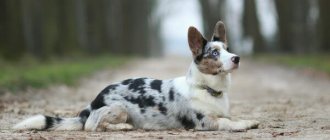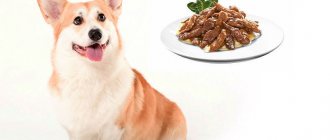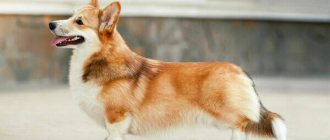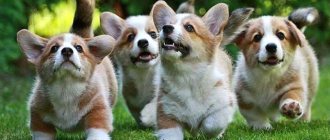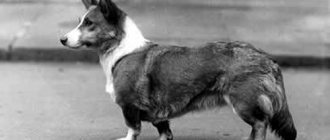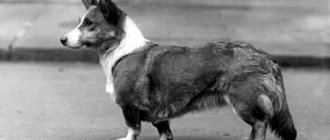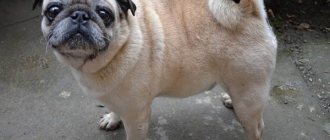Main characteristics
| Breed parameters | |
| Country of origin: | Great Britain |
| Weight of the breed: | 12–13 kg |
| Height at withers: | 30 cm |
| Temperament: | active |
| Wool: | short |
| Role in human life: | companion |
The dogs came to us from England, therefore they have typically English traits: integrity of character, compact physique, stamina and endurance. Although there are no birds or sheep to graze right now, the pets will gladly carry out any instructions from the owner.
What you need to train a Pembroke Welsh Corgi
To train a Pembroke Welsh Corgi, you definitely need treats, they can be sausages, boiled sausage, low-fat cheese or frolics (this treat is convenient because it is inexpensive, not dry, easily breaks into pieces, is stored well in a closed bag, and dogs love it) , you can also buy special treats at a pet store, but they should not be given to the dog in large quantities. The main thing is that the dog is ready to work for treats (and not just receive it in everyday life). It is also recommended that the treat should not be dry (the puppy may choke on it), it should easily break into manageable pieces, and not stick to your hands or pocket.
You should not allow the puppy to run away after punishment, because in this case, from the dog’s point of view, this skirmish is its victory or, in the worst case, a draw. Make her wait until you let her go.
It is necessary that you and your dog engage in activities with pleasure, as if playing. And let it bring joy to both you and your pet.
Origin
The history of the Welsh Corgi breed begins in the 10th century. It was to this time that archaeologists excavating a long-standing settlement in South Wales attribute the remains of a purebred dog found at this site, which in appearance is very similar to the bone structure of modern representatives. Information about their ancestors is found in the laws authored by Hywel the Good, the king of Wales in the 10th century. From written references it becomes clear: at that time, corgis were highly valued and were used as herding dogs. For killing a four-legged assistant, his owner could demand a whole ox.
Indeed, animals were very useful on the farm. Their value lay in the ability to independently herd sheep and other livestock without human intervention. The dogs herded the herd, protected it from predators and thieves, so losing such a helper was very tragic.
Animals first appeared on the lands of Great Britain thanks to the Vikings. It is noted that the ancestors of modern Welsh Corgis could be Lundehunds or Vallhunds: all these breeds are united by the structure of the auricle, into which sand or moisture could not get. Corgis didn't just herd sheep; they coped with herds of ponies, and then with poultry, when active breeding began in the country. The owners kept several four-legged shepherds who drove large flocks of poultry without loss.
The breed officially made its debut in 1925 in England, and its two subspecies - Pembroke and Cardigan - were not separated until the British Kennel Club recognized them as separate in 1934. At the same time, they allowed their tails to be docked to make it easier to navigate.
Characteristic
The description of an adult Welsh Corgi is as follows: they are strong, short, well-built animals. Their body looks half as long as the height at the withers, which is a maximum of 30 cm. The weight of males is a little over 13 kg, females - about 12 kg. Corgis have a fox-like muzzle, their head is wide and flat; the nose is only black. Their jaws are strong and strong, their eyes are round, brown, and go well with the color of their coat.
The ears are medium with rounded ends. The tail is short; can be stopped or remain in natural size. The limbs of pets are strong and short, with dense pads and short claws.
The coat is always straight and the undercoat is dense. A soft or wavy coat is considered a deviation from the standard. There are several color options:
- Ginger.
- Light red.
- Black with tan markings on the paws, neck and chest.
- Sable.
- White with tan.
- Marble.
There are two varieties of Welsh Corgis: the Pembroke, which originates from Pembrokeshire, and the Cardigan, which originates from Cardiganshire. Although the names are almost the same, the pets are different and each have their own characteristics. The dorgi, a cross between a corgi and a dachshund, is becoming popular.
How long do pets live: 12–15 years.
Origin story
To this day, it is not known for certain when the Corgi dog appeared and where it came from. Over the entire existence of the species, the history of its appearance has acquired many legends; for this reason, today it is quite problematic to firmly say which of the available options is true.
According to one theory of origin, the first puppies were discovered by children herding cattle. The shepherds thought that these were fox cubs and took them into the house with them. The parents explained that these animals, the future breed of Welsh Corgi dogs, were a gift from the kind elves. The children grew up, and the puppies grew up with them, learning the art of herding. Of course, such a legend about the appearance of the species is very beautiful, but it has nothing to do with reality.
Much more believable is the version according to which these dogs are direct descendants of Lundehunds, brought to Britain by the Vikings in the 9th-10th centuries. These animals had large ears that stood in an unusual way and thus protected the auditory canal from wind, moisture and other environmental influences. The described dog, the Pembroke Welsh Corgi (the latter name was received in honor of the county where the puppies were first bred) was created to assist people in herding livestock.
Over a long period of time, animals with the most pronounced herding characteristics were selected. Since shepherd work required special qualities, the selection was carried out quite strictly. Officially, representatives of this breed appeared at the exhibition in 1925. By the way, many dog lovers wonder whether it is possible to give a dog a pumpkin? Yes, such a product is very useful for the animal.
Initially, the Cardigan and Pembroke varieties were exhibited at competitions as a single breed, and only in 1934 the British club decided to separate the Corgi line into different breeds - Cardigan and Pembroke.
Continuing the description of the Corgi dog breed, it should be noted that the Pembrokes had their tails docked, which added even more differences in the external characteristics of these breeds. Since 1933, when the Duke of York gave Corgi puppies to his daughters, the animals have been considered royalty. Today's Queen of Britain is not only an ardent fan of these dogs, but also one of the best experts. Read the article: Food for small dogs: what selection criteria exist?
Breed standards
Dogs of this species are small, energetic animals whose main advantage is their ability to herd livestock. The described Corgi Cardigan dog breed is distinguished by an elongated body, which is covered with thick, coarse hair with a soft undercoat. The head, as well as the shape of the tail, resemble that of a fox. According to standards, the height of the dog should be 27-32 centimeters, with a body weight of 11-17 kg.
The color can be any, with spots of absolutely any color, but white coloring should be present on most of the body. The shape of the head also resembles that of a fox. The skull is wide and flat with a weakly defined transition from the forehead to the nose. Closer to the nose, a narrowing of the dog's muzzle is noticeable. The forelimbs are slightly curved, large, but compact.
The tail of the Cardigan breed is long and bushy, while the Pembroke species has a docked tail. It should be noted that the price of a Corgi dog varies between 900-2200 thousand dollars, which depends on the age of the animal.
Character of the breed
Before continuing with the description of the breed, you should pay attention to the fact that today many owners of these dogs are wondering whether dogs can have chicken bones and in what form? According to veterinarians, it’s possible, but not everything. Continuing the story about this species, it can be noted that these dogs are distinguished by their friendly, good-natured and balanced character, great intelligence and the presence of a shepherd's instinct.
Corgis are loyal and affectionate dogs whose main character traits include:
- strongly attached to each family member;
- not aggressive towards strangers;
- gets along easily with other pets and is affectionate with children;
- very active and simply love energetic games, as well as walks;
- brave, not at all afraid of large dogs;
- They are distinguished by well-developed intuition, as well as sensitivity and can easily determine the mood of the owner;
- easily adapt to changes;
- despite their small size, they show themselves to be real guards and are ready to protect every family member;
- Having a shepherd instinct, in games with a person they predict his actions.
It is precisely because of such excellent performance and qualities that today the price of the Corgi dog breed is quite impressive.
Photos of Welsh Corgi
Character
Having weighed the pros and cons of the breed, we can characterize this little shepherd positively. She is very friendly to all people, active, and has great intelligence. Wariness may manifest itself towards other dogs, but towards humans there are only positive feelings.
Since the Welshman was a shepherd, he feels great in company, is smart and quick-witted, and hardy. At first glance, the animal’s appearance is not very conducive to high activity, but it really loves games, movement, and does not miss the opportunity to simply fool around. These touching shepherd dogs are never in a bad mood - they are eternal cheerful people who love communication, walks, even work, as evidenced by numerous pictures.
Corgi is very attached to humans. The dog always strives to be near the owner, and to actively participate in his activities: for example, sit next to him, poke his nose at the owner or touch him with his paw. She will persistently wait for the moment when the person is free to spend time only with her.
This is an excellent nanny for children who will endure all their pranks, games, cuddling, and without the slightest aggression. The pet always wants to be aware of what is happening, so he even chooses a place for himself near the aisle or in the busiest room of the house.
A characteristic feature of the breed, inherited from its shepherd ancestors, is fearlessness: and its modern representative, if necessary, will protect against an enemy much stronger than himself. They are very emotional and open, so they express emotions with a variety of sounds: whining, barking, muttering, grunting, squealing, grunting, and expressive enough for a person to notice it. Moreover, the tone of the voice is very low, which does not fit at all with the small size of the body.
Character and characteristics of the Welsh Corgi
Active, good-natured, affectionate – that’s what Welsh Corgis are all about. Thanks to the dark edging around the lips, it seems that the corgi is constantly smiling. They are really very cheerful. The two varieties of the breed are distinguished:
- dimensions;
- paw shape;
- structure of the head and body.
The Cardigan Welsh Corgi is slightly larger than the Pembroke. There are also differences in character. One is serious, reasonable. The other is active, mobile, attentive. There are also differences in what the corgi breeds were bred for:
- cardigan - for protecting and accompanying the herd;
- Pembroke - for maneuvering and managing the herd.
Although corgis do not have outstanding dimensions, they do not consider themselves small dogs and are ready to challenge a much larger individual. They are natural shepherds at heart.
Welsh Corgis have become true human companions. They get along with children and any animals. They do not get bored in the company of older people. Despite their short legs, corgis run fast. They will tirelessly accompany their owner on runs. Thanks to their developed intelligence and ability to sense a person’s mood, Welsh Cattle Dogs will not bother you and constantly demand attention.
The Welsh Corgi is one of the few breeds whose standard includes a sense of humor. With such a description, it is simply impossible not to fall in love with the breed.
Training
The natural intelligence and intelligence of pets allows you to achieve high results. They perceive this process as a game, so it is recommended to train puppies in a playful way. They begin training by getting the animal used to its name, then move on to standard commands. The “Aport” command is learned very well by him. These small shepherds themselves lack aggression, so they do not understand it on the part of the owner - therefore, it is simply unreasonable to show it. In training a corgi, only affection and patience will bring results.
Maintenance and care
Pets are great for an apartment or private home; they are easy to care for. Although they have thick hair with a dense undercoat, it is still better not to keep the dog in a kennel in the yard. Living in an apartment involves organizing the necessary physical activity. For this purpose, it is worth buying a lot of toys for your pet.
During a walk, it is important that the pet jumps as little as possible, but runs a lot. Due to their short legs and long back, the breed is not very prone to such tricks, especially since they can cause health problems due to excessive stress on the back.
Buying a Corgi
Today, finding a kennel where the Corgi dog breed is raised is not difficult. They are available in large quantities both in Russia and abroad, and there are also private breeders offering beautiful puppies from producers with excellent characteristics. By the way, on the Internet you can find a variety of dog names for small breeds to name your pet.
The difficulty lies in the exact price of these dogs. The cost of puppies is associated with a large number of factors - the name of the kennel, the gender of the puppy, the status of the parents, etc. Of course, puppies imported from abroad will cost an order of magnitude higher than when purchased in Russia. Taking into account the fact that this breed is not cheap at all, the price of an individual individual can be very high. The average price can fluctuate between 40-70 thousand rubles.
If the cost is lower, most likely, such an animal is of low quality. It should be noted that the following articles will discuss the question of what small dog breeds there are and what their distinctive features are.
Summarizing the results of this article, we can conclude that the dog breed described in the above text is a good option for keeping at home. After all, such small and medium-sized dog breeds do not take up much space, and they also do not require a large amount of food, which significantly saves the family budget.
And at the same time, these pets are amazingly beautiful and friendly. They are selflessly devoted to their owners and will protect them from any danger by all available means. Corgis are so active and playful that they are sometimes ready to destroy everything in their path. An important fact is that they get along well with any pets. They respond well to children. We recommend reading the article: Dry dog food: what is special about using such food?
Nutrition
When feeding dry matter, it is better to choose premium products. A diet made up of natural products must be balanced:
| Meat | Beef, except poultry, offal |
| Porridge | Rice, buckwheat, except pearl barley, peas, lentils |
| Eggs | Can be consumed 2 times a week |
| Cottage cheese | Low-fat only |
| Vegetables fruits | Carrot, apple, zucchini |
You can add vitamin complexes. It is forbidden to give the animal fish in any form, cartilage, cucumbers, cabbage, pumpkin, broth.
Corgis should not be fed on demand as they are very prone to overeating. You should strictly adhere to the schedule: at 2-3 months the dog eats 5 times a day, at 6 months - 4 times, and from 8 months - 2 times. In hot weather, it makes sense to have a fasting day with one meal.
How to feed correctly and how often?
Proper nutrition means not only the quality of food, but also the regularity of feeding and the volume of portions.
Feeding frequency:
- A 2-month-old puppy should be fed 6 times a day in divided portions.
- At 3-5 months, the baby needs 5 meals a day.
- At 6 months of age, the dog can be switched to 3 meals a day.
- At 10 months of age, the puppy can eat 2 times a day.
70% of a Welsh Corgi's diet should consist of foods containing protein.
Menu for the week
Monday:
- Breakfast - cottage cheese, kefir or yogurt.
- Lunch - buckwheat porridge with boiled lung.
- Dinner – a piece of fish.
Tuesday:
- Breakfast - kefir or cottage cheese.
- Lunch – rice porridge with boiled turkey.
- Dinner - boiled beef with cabbage.
Wednesday:
- Breakfast – low-fat broth.
- Lunch – buckwheat porridge with liver.
- Dinner – oatmeal with fish.
Thursday:
- Breakfast: cottage cheese or kefir.
- Lunch – low-fat broth with a piece of meat.
- Dinner – rice porridge with liver.
Friday:
- Breakfast - low-fat chicken broth.
- Lunch - buckwheat with boiled heart.
- Dinner – kefir or cottage cheese.
Saturday:
- Breakfast – low-fat boiled fish.
- Lunch – buckwheat porridge and a piece of chicken.
- Dinner – oatmeal with stewed cabbage.
Sunday:
- Breakfast - yogurt, cottage cheese or kefir.
- Lunch – rice porridge with heart.
- Dinner – stewed beets with fish.
From an early age, accustom your pet to a limited amount of food, give exactly as much as necessary.
Diseases
Nature rewarded the corgi with good health - herding work required not sissies, but strong and hardy workers. It is enough to get vaccinated on time to prevent diseases from occurring. True, genetically small shepherd dogs are predisposed to:
- Narcolepsy – This especially applies to puppies.
- Pathologies of intervertebral discs, urinary tract.
- Overeating - you need to firmly wean your pet from handouts from the master's table.
- Hip dysplasia – puppies are especially susceptible to it.
- Glaucoma.
- Ehlersom-Danlos syndrome.
- Obesity.
Photos of Welsh Corgi puppies
Choosing a puppy
Every dog breeder knows that you should choose a Welsh Corgi puppy from a reputable breeder. But it is important to pay attention to the health of not only the baby, but also his mother. The peculiarity of this breed is that most diseases are transmitted through the maternal line. Therefore, you need to find out more information about the health of the bitch.
A normal puppy is curious, cheerful and even obsessive. At one and a half months, his ears must be erect, his eyes must be dark in color and round in shape, as in the photo. For exhibition achievements, a baby with a fox face is perfect - mischievous and cunning, this is very valuable.
There are no differences between the sexes in character and temperament. The boy and the girl are equally smart, smart and cheerful. Their price ranges from 63 to 150 thousand rubles.
Possible diseases and methods of treating them
Welsh Corgis have not only an affable character and excellent intelligence, but also excellent health. It is extremely rare to suffer from epilepsy or hip dysplasia. However, they may suffer from ear diseases.
This part of the body in dogs is large and thick. Some owners forget to wash it, as a result of which sulfur accumulates there, and dangerous infections love to settle on it. As a result, inflammation, itching and even suppuration of the canals occurs.
Only a doctor can treat ear disease in a dog. Usually in this case, he prescribes drops that owners instill in their pets themselves at home. This wonderful mini shepherd can also suffer from food allergies. Symptoms:
- Vomit.
- Itching all over the body.
- Suspicious discharge from mucous membranes.
- Redness of the whites of the eyes.
- Diarrhea.
To avoid this disease in your pet, do not give him foods with spices, fatty, fried and smoked foods. All this is difficult for his stomach to digest and can cause complications in the gastrointestinal tract as a whole.
